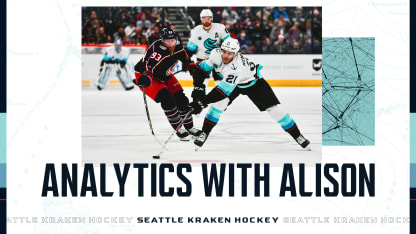"We had a one-goal lead going in, we lost that lead," Hakstol stated post-game. "It's a good road point, (but) you're always disappointed when you go into the third period with a lead."
After two games - one of which was a win! - where the Kraken were outshot in the third period, a question started to come to the forefront: Is something going on in the final 20 minutes of the game? The answer is yes, but also, guess what, it happens all over the NHL and it's happened for a long time.
Let's dig in.
Sometimes called "score effects," all the way back in 2009, hockey analysts
identified that leading teams tend to play more defensively when they have a lead of any size
. This was mainly defined by how many shots a team did or didn't take and when.
Why might this happen? A better way to think about it is in terms of "leverage" or the "value" of working for a goal for, versus the "value" of allowing a goal against.
There has been work done on this idea, too, showing that
it can be logical to consider that it's more valuable to fight to protect a pending victory versus perhaps taking more risks to score or play with a completely offensive mindset
.
There's a reason extra goals late are often referred to as "insurance goals" because that is exactly what this concept is all about. Just as someone who lives in Florida may think it's absolutely essential to have hurricane insurance, someone in Seattle may be willing to take the risk they are not likely to need such coverage.
Hockey, like any sport, is a series of a ton of different evaluations and decisions. Each one relies in some way on evaluating if risk taken is worth possible reward.
That's why so many teams in so many games are willing to play a less risky game in order to protect a lead.
Maybe this still all sounds worrisome, but it shouldn't, because here's the interesting part. In 2020, Micah Blake McCurdy of HockeyViz identified this shift in play is controlled by the team with the lead. It's not that trailing teams are suddenly surging or finding a way to confound leading teams, it's that leading teams play protectively, (you can read McCurdy's full writeup
here
).
This behavior has been on full display in the Kraken's last two games. According to naturalstattrick.com, in Nashville, the Predators' shot count in both the second and third periods was 13, and their unblocked shot attempt count actually went down by two!
Similarly, in Columbus, the Blue Jackets had nine shots on goal in period two and eight in period three. In both of these games, it was the Kraken that reduced their shot rates, not their opponents that suddenly overwhelmed them.
Hakstol is always evaluating, and he has identified what has contributed to this behavior.
Certainly, as the head coach noted, in Nashville, the team may have been feeling the stress of being on the cusp of the first win in franchise history - something highly meaningful to them.
In Columbus, Hakstol had targets identified immediately after the game.
"The Nashville game we had trouble breaking out, we weren't calm and controlled with the puck," Hakstol said. "This was different. We didn't spend all that much time in our D-zone, but we gave up too much off the rush … most of those were in the second half of the game."
Hakstol knows of what he speaks. According to Sportlogiq, while Seattle had just :38 of possession time in the offensive zone in period three in Nashville, in Columbus they had 2:07 of possession time in the attack zone which was consistent with the first (2:07) and second (2:20) periods Saturday.
And as for those rush attacks, against the Predators, the Kraken limited scoring chances off the rush to two in the final frame, however in Columbus, they allowed six.
"It wasn't perfect in the third period," Hakstol said, acknowledging the need to "push, extend and close out the game."
Thinking about leverage and valuing goals is a real thing that affects all teams. For the Kraken, the goal for performance is in place, the areas for improvement are identified and, as the Kraken solidify their identity, systems can continue to come together.

